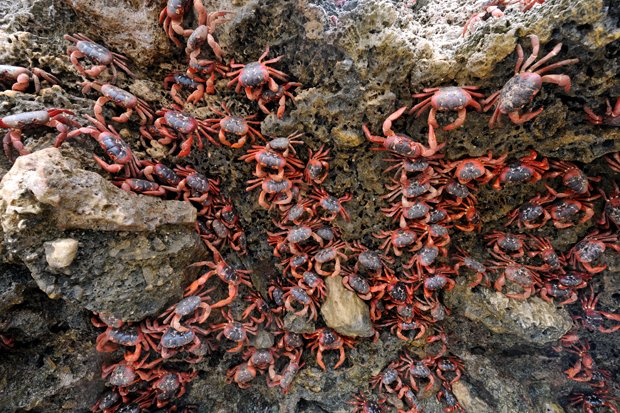March of the Christmas Island crabs

HAVING BEEN A PROFESSIONAL photographer for over 20 years, there has been one wonder in the animal world I have always wanted to shoot: one of the most amazing migrations which takes place each year on Christmas Island.
This annual event sees millions of terrestrial red crabs swarm across the island in the hope of making it to the sea. An Australian territory, Christmas Island lies some 2600 km north-west of Perth in the middle of the Indian Ocean. While just 1500 people live there, it is home to an estimated 120 million crabs.
Most of these are endemic red crabs (Gecarcoidea natalis), which spend much of their time living in burrows on the rainforest floor in order to avoid drying out in the fierce sun. But when the time is right – according to the tides and phases of the Moon – they embark on the journey of their lives.
The mass migration is headed by the males, quickly followed by the females. The crabs spend several painstaking weeks scuttling to the ocean, which can be as far as 9 km away.
Along the way they face numerous hazards. While the locals do the best as they can, according to ranger Max Orchard each year up to half a million crabs never return from their perilous journey. Many of these casualties fall under the wheels of vehicles as they attempt to traverse local roads, while others are attacked by yellow crazy ants.
Once the males arrive at the sea, they dig special burrows, where mating takes place once the females arrive. After the deed is done, the males begin the arduous journey back inland while the females remain in the burrows for about two weeks, laying eggs and waiting for them to develop. The eggs are held in a brood pouch – located between the female crab’s abdomen and thorax – which can each hold as many as 100,000 eggs.
When the time is right, just before dawn at high tide, the egg-laden females descend to the waterline to release their eggs, a process that can occur over several nights.
I joined excited locals and some visiting bird watchers from Australia to witness one of these particular nights. Walking in the dark armed with torches and in torrential rain, we made our way to Ethel Beach on the island to witness one of these amazing dawns!
Once the crab eggs are dropped, the females begin the march back to the centre of the island. Meanwhile, after coming in contact with the sea water, the eggs hatch immediately and release clouds of young larvae. Many of these do not survive as they are eaten by predators, but those that do, develop into prawn-like animals called megalopae.
These gather in pools close to the shore for several days to finish the process of turning into young crabs. Leaving the water, the tiny baby crabs measure just 5 mm across. However, this doesn’t stop them from following in their parents’ footsteps and beginning the long march again.
LINKS
For more of James’s images, see his website.
A video of the perilous migration of red crabs
RELATED STORIES

